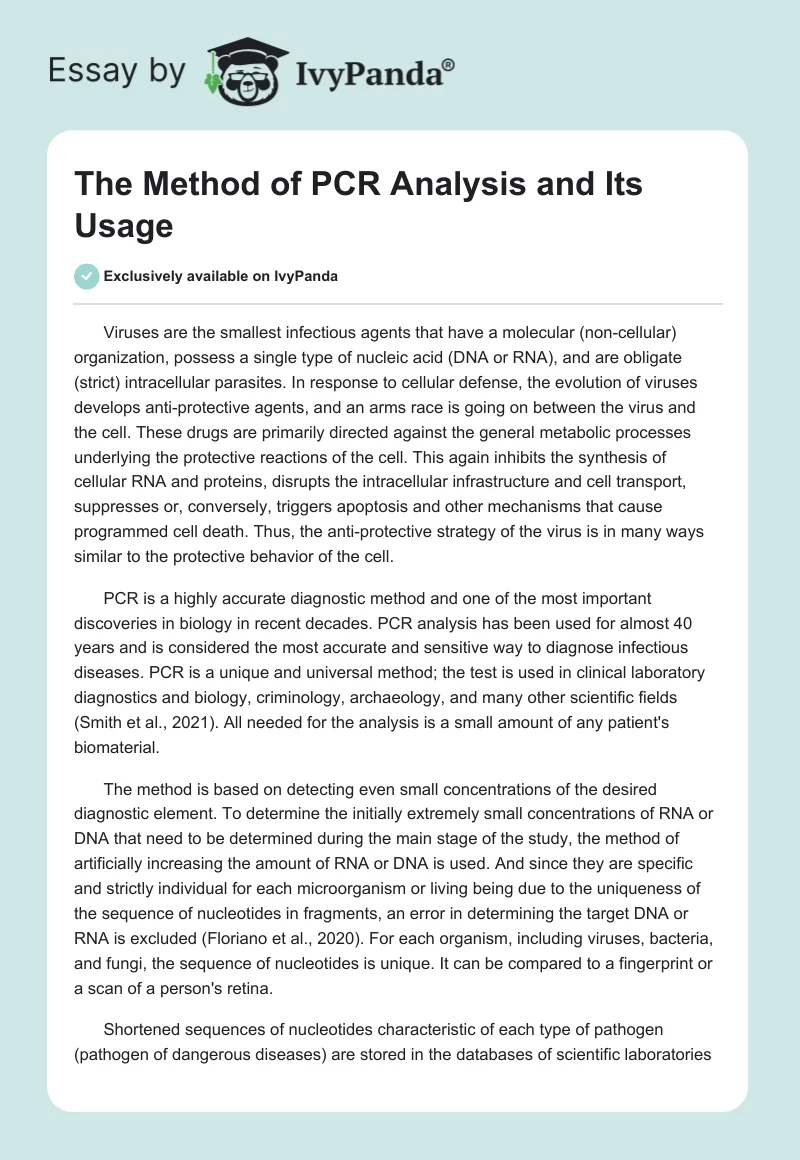Viruses are the smallest infectious agents that have a molecular (non-cellular) organization, possess a single type of nucleic acid (DNA or RNA), and are obligate (strict) intracellular parasites. In response to cellular defense, the evolution of viruses develops anti-protective agents, and an arms race is going on between the virus and the cell. These drugs are primarily directed against the general metabolic processes underlying the protective reactions of the cell. This again inhibits the synthesis of cellular RNA and proteins, disrupts the intracellular infrastructure and cell transport, suppresses or, conversely, triggers apoptosis and other mechanisms that cause programmed cell death. Thus, the anti-protective strategy of the virus is in many ways similar to the protective behavior of the cell.
PCR is a highly accurate diagnostic method and one of the most important discoveries in biology in recent decades. PCR analysis has been used for almost 40 years and is considered the most accurate and sensitive way to diagnose infectious diseases. PCR is a unique and universal method; the test is used in clinical laboratory diagnostics and biology, criminology, archaeology, and many other scientific fields (Smith et al., 2021). All needed for the analysis is a small amount of any patient’s biomaterial.
The method is based on detecting even small concentrations of the desired diagnostic element. To determine the initially extremely small concentrations of RNA or DNA that need to be determined during the main stage of the study, the method of artificially increasing the amount of RNA or DNA is used. And since they are specific and strictly individual for each microorganism or living being due to the uniqueness of the sequence of nucleotides in fragments, an error in determining the target DNA or RNA is excluded (Floriano et al., 2020). For each organism, including viruses, bacteria, and fungi, the sequence of nucleotides is unique. It can be compared to a fingerprint or a scan of a person’s retina.
Shortened sequences of nucleotides characteristic of each type of pathogen (pathogen of dangerous diseases) are stored in the databases of scientific laboratories in the form of primers – separate DNA sections typical of only a specific pathogen. These sections are much shorter than any DNA molecule. Such primers attach to the DNA of the pathogen in the sample and, under the action of catalysts, repeatedly reproduce their duplicates (Smith et al., 2021). This process is called “replication” – multiple magnifications, duplication of the desired area until it becomes available for definition. The replication process is possible only if the pathogen DNA is present in the sample.
The main advantage of this method is its high sensitivity and the ability to detect the pathogen itself both qualitatively and quantitatively. Determining the number of microorganisms is a good help for the attending physician, as it allows you to assess the extent of the lesion and the effectiveness of the treatment. The indisputable advantage of PCR diagnostics is the suitability of various types of biological material of the patient: blood, urine, and feces (Smith et al., 2021). Several pathogens can be detected in one sample of the material. Among the advantages of PCR diagnostics, I would also attribute the fact that this is a hardware technique that practically excludes subjectivity in evaluating biological material.
Infectious disease specialists actively use PCR to diagnose tuberculosis, HIV, viral hepatitis, herpes, mononucleosis, and Epstein-Barr virus. Also, thanks to PCR, doctors can identify whooping cough and paracoccussis with confidence within a few days, and identify the causative agents of the SARS epidemic. The types of influenza virus circulating in a certain territory are being clarified, based on which it becomes possible to develop an effective vaccine for each flu season. Within a day or faster, it is possible to determine the type of causative agent of intestinal infection, which means that adequate treatment can be prescribed and a probable source of infection can be detected. Thus in medicine, PCR is used wherever high accuracy and speed of obtaining results are needed.
References
Floriano, I., Silvinato, A., Bernardo, W. M., Reis, J. C., & Soledade, G. (2020). Accuracy of the Polymerase Chain Reaction (PCR) test in the diagnosis of acute respiratory syndrome due to coronavirus: a systematic review and meta-analysis. Revista da Associação Médica Brasileira, 66, 880-888. Web.
Smith, L. E., Potts, H. W., Amlȏt, R., Fear, N. T., Michie, S., & Rubin, G. J. (2021). Do members of the public think they should use lateral flow tests (LFT) or polymerase chain reaction (PCR) tests when they have COVID-19-like symptoms? The COVID-19 Rapid Survey of Adherence to Interventions and Responses study. Public Health, 198, 260-262. Web.


